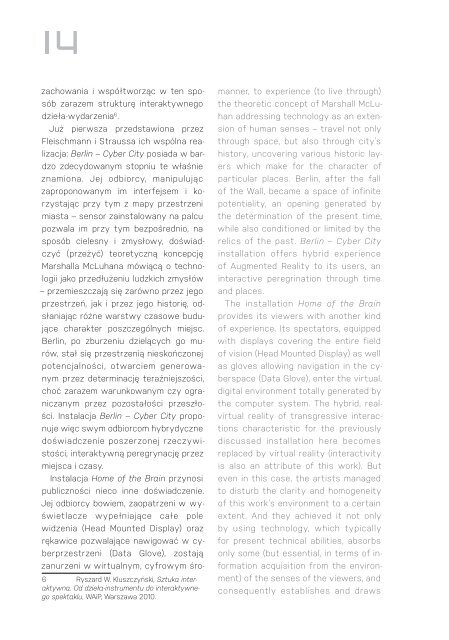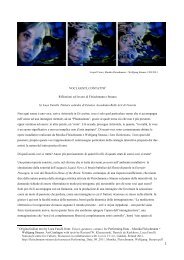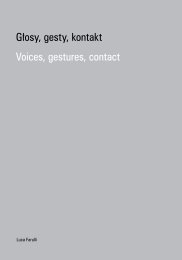Performing Data | Monika Fleischmann + Wolfgang Strauss
Performing Data is a review of Monika Fleischmann´s and Wolfgang Strauss´artistic body of work and a catalogue of their exhibition in Poland 2011. It presents works from Virtual Reality (Home of the Brain) up to Mixed Reality (Murmuring Fields) from Fluid Interface (Liquid Views) up to Floating Interface (Medienfluss) and texts by Ryszard W. Kluszczynski, Derrick de Kerkhove, Luca Farulli. Monika Fleischmann and Wolfgang Strauss from the German Fraunhofer research institute show us an intersection of the body and immaterial digital data. Immersion in data flow causes productive moments of disturbance and suspension, and consequently – a feeling of real physical presence. Fleischmann, Monika; Strauss, Wolfgang: Performing Data | Performowanie danych. National Centre for Culture, Warszawa 2011 in collaboration with Laznia CCArt, Gdańsk, Poland 2011 ISBN 978-83-61587-55-2 (en/pl) http://artline-southbaltic.eu/de/event/performing-data/
Performing Data is a review of Monika Fleischmann´s and Wolfgang Strauss´artistic body of work and a catalogue of their exhibition in Poland 2011. It presents works from Virtual Reality (Home of the Brain) up to Mixed Reality (Murmuring Fields) from Fluid Interface (Liquid Views) up to Floating Interface (Medienfluss) and texts by Ryszard W. Kluszczynski, Derrick de Kerkhove, Luca Farulli.
Monika Fleischmann and Wolfgang Strauss from the German Fraunhofer research institute show us an intersection of the body and immaterial digital data. Immersion in data flow causes productive moments of disturbance and suspension, and consequently – a feeling of real physical presence.
Fleischmann, Monika; Strauss, Wolfgang: Performing Data | Performowanie danych. National Centre for Culture, Warszawa 2011 in collaboration with Laznia CCArt, Gdańsk, Poland 2011 ISBN 978-83-61587-55-2 (en/pl) http://artline-southbaltic.eu/de/event/performing-data/
You also want an ePaper? Increase the reach of your titles
YUMPU automatically turns print PDFs into web optimized ePapers that Google loves.
zachowania i współtworząc w ten sposób<br />
zarazem strukturę interaktywnego<br />
dzieła-wydarzenia 6 .<br />
Już pierwsza przedstawiona przez<br />
<strong>Fleischmann</strong> i <strong>Strauss</strong>a ich wspólna realizacja:<br />
Berlin – Cyber City posiada w bardzo<br />
zdecydowanym stopniu te właśnie<br />
znamiona. Jej odbiorcy, manipulując<br />
zaproponowanym im interfejsem i korzystając<br />
przy tym z mapy przestrzeni<br />
miasta – sensor zainstalowany na palcu<br />
pozwala im przy tym bezpośrednio, na<br />
sposób cielesny i zmysłowy, doświadczyć<br />
(przeżyć) teoretyczną koncepcję<br />
Marshalla McLuhana mówiącą o technologii<br />
jako przedłużeniu ludzkich zmysłów<br />
– przemieszczają się zarówno przez jego<br />
przestrzeń, jak i przez jego historię, odsłaniając<br />
różne warstwy czasowe budujące<br />
charakter poszczególnych miejsc.<br />
Berlin, po zburzeniu dzielących go murów,<br />
stał się przestrzenią nieskończonej<br />
potencjalności, otwarciem generowanym<br />
przez determinację teraźniejszości,<br />
choć zarazem warunkowanym czy ograniczanym<br />
przez pozostałości przeszłości.<br />
Instalacja Berlin – Cyber City proponuje<br />
więc swym odbiorcom hybrydyczne<br />
doświadczenie poszerzonej rzeczywistości,<br />
interaktywną peregrynację przez<br />
miejsca i czasy.<br />
Instalacja Home of the Brain przynosi<br />
publiczności nieco inne doświadczenie.<br />
Jej odbiorcy bowiem, zaopatrzeni w wyświetlacze<br />
wypełniające całe pole<br />
widzenia (Head Mounted Display) oraz<br />
rękawice pozwalające nawigować w cyberprzestrzeni<br />
(<strong>Data</strong> Glove), zostają<br />
zanurzeni w wirtualnym, cyfrowym śro-<br />
6 Ryszard W. Kluszczyński, Sztuka interaktywna.<br />
Od dzieła-instrumentu do interaktywnego<br />
spektaklu, WAiP, Warszawa 2010.<br />
manner, to experience (to live through)<br />
the theoretic concept of Marshall McLuhan<br />
addressing technology as an extension<br />
of human senses – travel not only<br />
through space, but also through city’s<br />
history, uncovering various historic layers<br />
which make for the character of<br />
particular places. Berlin, after the fall<br />
of the Wall, became a space of infinite<br />
potentiality, an opening generated by<br />
the determination of the present time,<br />
while also conditioned or limited by the<br />
relics of the past. Berlin – Cyber City<br />
installation offers hybrid experience<br />
of Augmented Reality to its users, an<br />
interactive peregrination through time<br />
and places.<br />
The installation Home of the Brain<br />
provides its viewers with another kind<br />
of experience. Its spectators, equipped<br />
with displays covering the entire field<br />
of vision (Head Mounted Display) as well<br />
as gloves allowing navigation in the cyberspace<br />
(<strong>Data</strong> Glove), enter the virtual,<br />
digital environment totally generated by<br />
the computer system. The hybrid, realvirtual<br />
reality of transgressive interactions<br />
characteristic for the previously<br />
discussed installation here becomes<br />
replaced by virtual reality (interactivity<br />
is also an attribute of this work). But<br />
even in this case, the artists managed<br />
to disturb the clarity and homogeneity<br />
of this work’s environment to a certain<br />
extent. And they achieved it not only<br />
by using technology, which typically<br />
for present technical abilities, absorbs<br />
only some (but essential, in terms of information<br />
acquisition from the environment)<br />
of the senses of the viewers, and<br />
consequently establishes and draws







